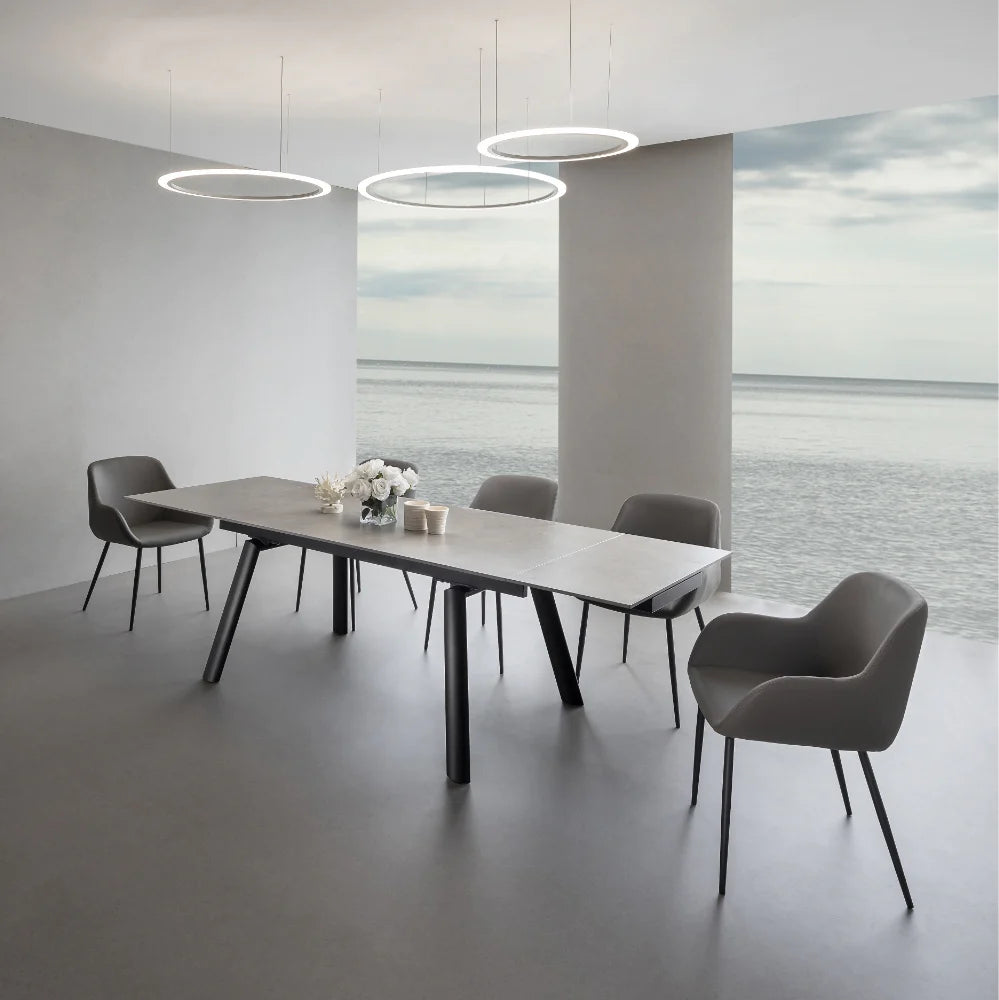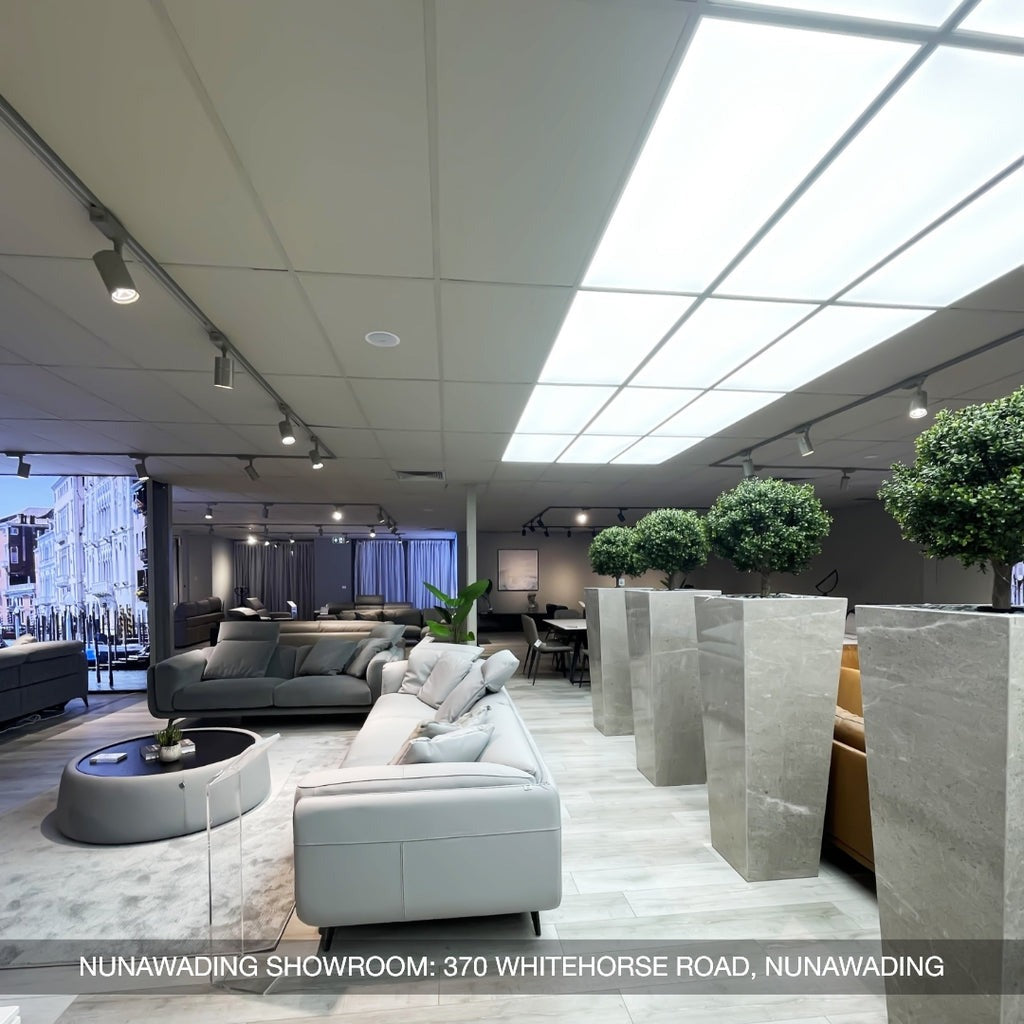The quest for the perfect ceramic dining table is a nuanced exploration of aesthetics and functionality. As the focal point of gatherings, the choice between round table vs rectangular table and oval vs rectangle dining table becomes pivotal. Each shape carries its own charm, influencing the ambiance of your space.
In this discerning pursuit, we delve into the intricacies of form and function, guiding you through the considerations that define your dining experience. Join us on a journey to discover the ceramic table shape that harmonizes seamlessly with your space, capturing the essence of conviviality and style.
Oval Ceramic Tables: A Blend Of Elegance And Efficiency
Advantages And Features Of Oval Ceramic Tables
Advantages And Features Of Oval Ceramic Tables
Beyond their aesthetic appeal, oval dining tables boast practical advantages that elevate the dining experience. The rounded edges foster a sense of inclusivity, encouraging engaging conversations without the hierarchical structure often associated with rectangular tables. Are oval dining tables good? Absolutely. The organic form promotes a harmonious flow in the dining space, making them ideal for both intimate gatherings and larger festivities.

The absence of sharp corners fosters inclusivity, creating a dining experience that encourages engaging conversations and a sense of shared space.
In the perennial debate of oval vs rectangle dining table, oval tables stand out for their space-efficient design, accommodating more guests without sacrificing legroom. This shape also lends itself well to various interior styles, seamlessly blending with modern or traditional decor. The curvature of oval tables softens the overall aesthetic, creating an inviting atmosphere. As we navigate the nuances of dining table selection, the advantages and features of oval ceramic tables emerge as a compelling choice for those seeking both form and function in their dining spaces.
Ideal Room Spaces For Oval Ceramic Table
Smaller Dining Areas Or Kitchens
Oval ceramic tables, with their inherently space-efficient design, find their ideal home in smaller dining areas or kitchens. The rounded edges of an oval table contribute to a sense of flow and ease of movement, making them particularly well-suited for cozier spaces. The absence of sharp corners allows for better traffic flow around the table, creating an inviting environment where every inch of the room is maximized. This is especially evident in compact urban apartments or cozy breakfast nooks, where the adaptability of oval tables enhances both functionality and aesthetics.
Open-Plan Layouts
In open-plan layouts, where the boundaries between the kitchen, dining, and living areas blur, oval ceramic tables shine as versatile centerpieces. The organic form seamlessly integrates with the fluidity of open spaces, acting as a unifying element that effortlessly connects different functional zones. This adaptability fosters a harmonious visual continuity, contributing to an overall cohesive design. Whether it's the heart of a bustling family home or a contemporary loft with an open layout, oval tables become a focal point that bridges diverse living spaces.
Modern Or Contemporary Settings
Modern or contemporary settings, characterized by clean lines and a focus on fluid design, benefit immensely from the introduction of oval ceramic tables. The sleek, organic shape of these tables aligns perfectly with the aesthetics of modern interiors, offering a refreshing departure from traditional rectangular options. The versatility of oval tables complements a range of contemporary design elements, from minimalist furniture to statement lighting fixtures, creating a cohesive and visually appealing atmosphere. In these settings, the oval table becomes a design statement, marrying form and function seamlessly.
Rectangular Ceramic Tables: The Classic Choice
Advantages And Features Of Rectangular Ceramic Tables
Advantages And Features Of Rectangular Ceramic Tables
Their elongated design not only lends itself to a sleek and modern aesthetic but also maximizes practicality in various settings. In the age-old debate of round vs rectangular dining table, the latter stands tall in its adaptability. Rectangular tables, with their straight lines and defined edges, effortlessly integrate into both traditional and contemporary spaces.
One notable advantage lies in the efficient utilization of space. Rectangular tables optimize room layouts, making them ideal for both expansive dining areas and more compact rooms. The extended surface area provides ample space for elaborate table settings or family-style dining, catering to diverse preferences. Beyond spatial considerations, the rectangular shape facilitates a sense of order and structure, making it particularly well-suited for formal dining environments.

The elongated design of rectangular tables not only embraces a sleek and modern aesthetic but also proves to be a paragon of practicality across diverse settings.
Moreover, the flexibility of rectangular ceramic tables shines through in their ability to accommodate varying guest numbers. Whether hosting an intimate dinner for two or a festive gathering, the elongated shape allows for seamless placement of chairs, fostering an inclusive and inviting atmosphere. As we explore the advantages and features of rectangular ceramic tables, their versatility, spatial efficiency, and timeless design elevate them as enduring staples in the ever-evolving landscape of dining aesthetics.
Ideal Room Spaces For Rectangular Ceramic Tables
Spacious Dining Rooms
Rectangular ceramic tables effortlessly claim their place as the centerpiece of spacious dining rooms. The elongated design of these tables harmonizes with the expansive layout, creating a sense of balance and proportion. The ample surface area accommodates larger groups, allowing for gracious entertaining without sacrificing comfort. The straight lines of the rectangular shape align with the architecture of generously sized dining areas, presenting a visually satisfying focal point. The proportions of the table resonate with the scale of the room, imparting a sense of grandeur and sophistication.
Multifunctional Living Areas
In multifunctional living areas where boundaries between dining, living, and workspace blur, rectangular ceramic tables emerge as versatile allies. Their streamlined form seamlessly integrates into diverse setups, providing a designated dining space without imposing on the multifaceted nature of the room. This adaptability is evident in modern homes where the dining area transitions seamlessly into a communal workspace or a casual lounge. The structured lines of rectangular tables maintain a sense of order in these multifunctional spaces, fostering a cohesive and organized ambiance.
Traditional Or Formal Settings
Traditional or formal settings, characterized by a sense of timeless elegance, find a perfect match in rectangular ceramic tables. The classic shape aligns with the formality of these environments, providing a canvas for elaborate table settings and refined decor. The linear symmetry of the table complements traditional design elements, from ornate chandeliers to intricate woodwork. In formal dining rooms, the rectangular ceramic table becomes a symbol of enduring sophistication, adding a touch of grace and refinement to the traditional aesthetic.
Round Ceramic Tables: Fostering Intimacy And Conversation
Advantages And Features Of Round Ceramic Tables
Advantages And Features Of Round Ceramic Tables
In the perennial debate of do round or rectangular tables take up more space and are round tables more space saving, their absence of corners allows for a more fluid and flexible arrangement, making them particularly well-suited for smaller dining areas or cozy kitchens. The rounded form fosters an inclusive atmosphere, facilitating easy conversation and a sense of togetherness, making round tables an ideal choice for intimate gatherings.

Round tables become ideal choices for intimate gatherings, creating a communal setting where everyone feels connected and engaged.
The question of whether round tables are more space-saving finds a resounding affirmation. The circular shape maximizes seating capacity without the need for elongated sides, allowing for efficient placement in various room configurations. This feature proves invaluable in compact urban dwellings or open-plan layouts where space optimization is paramount. The versatility of round ceramic tables extends beyond spatial considerations; their aesthetic appeal lends itself to diverse interior styles, from classic to contemporary, making them a versatile choice for those seeking a balance of form and function in their dining spaces.
The advantages and features of round ceramic tables go beyond their spatial efficiency. The absence of sharp edges enhances safety, making them an excellent option for homes with young children. The rounded form also adds a touch of softness to the overall aesthetic, creating a visually appealing focal point. As we unravel the virtues of round tables, it becomes evident that their space-saving prowess, coupled with their aesthetic versatility, positions them as not just functional pieces but as statements of style in the ever-evolving landscape of dining aesthetics.
Ideal Room Spaces For Round Ceramic Tables
Cozy Breakfast Nooks
Round ceramic tables, with their charming symmetry and space-efficient design, seamlessly integrate into various room spaces, offering a distinct allure that suits specific settings. In cozy breakfast nooks, where space is often at a premium, the rounded silhouette of a round table proves to be an ideal choice. The absence of corners not only enhances traffic flow in these compact areas but also fosters an intimate atmosphere, making it the perfect spot for a leisurely morning meal or a casual cup of coffee. The dining table shape becomes a pivotal element, transforming these nooks into inviting and functional spaces that prioritize both style and comfort.
Smaller Dining Rooms
Smaller dining rooms benefit significantly from the space-saving attributes of round ceramic tables. The circular design efficiently utilizes the available square footage, allowing for optimal placement of chairs without the constraints imposed by the elongated sides of rectangular tables. This spatial efficiency is particularly evident in apartments or homes with limited dining space, where the dining table shape becomes a strategic choice to create an uncluttered and visually open environment. The rounded form not only contributes to a seamless layout but also enhances the overall aesthetic, adding a touch of sophistication to smaller dining areas.
Intimate Conversation Areas
In intimate conversation areas, round ceramic tables play a central role in fostering a sense of closeness and engagement. The circular shape encourages face-to-face interaction, making it conducive to shared moments and meaningful conversations. The absence of sharp edges enhances the flow of communication, creating a more relaxed and inviting ambiance. Whether placed in a corner of the living room or as a centerpiece in a dedicated conversation space, the dining table shape becomes a design element that accentuates the intimacy and warmth of these areas, making round tables a natural choice for those seeking both functionality and style in their living spaces.
Conclusion
In the nuanced quest for the perfect ceramic dining table shape, considerations of space, style, and functionality intertwine. Whether opting for the space-efficient charm of round tables, the versatile adaptability of rectangular tables, or the inviting elegance of oval tables, the choice ultimately hinges on personal preferences and room dynamics.
Understanding what shape table is best for a small space becomes pivotal in maximizing utility without compromising aesthetics. Whether you envision a cozy breakfast nook with a round table, a spacious dining room adorned with a rectangular centerpiece, or the timeless allure of an elegant ceramic dining table, the decision is a reflection of your unique taste and the harmonious integration of form and function in your living space.




